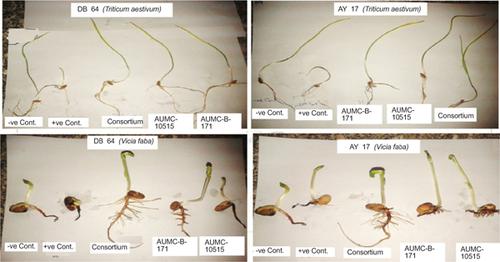当前位置:
X-MOL 学术
›
Curr. Genomics
›
论文详情
Our official English website, www.x-mol.net, welcomes your
feedback! (Note: you will need to create a separate account there.)
Role of Bacterial-Fungal Consortium for Enhancement the Degradation of Industrial Dyes
Current Genomics ( IF 1.8 ) Pub Date : 2020-08-08 , DOI: 10.2174/1389202921999200505082901 Asmaa M M Mawad 1 , Abd El-Latif Hesham 1 , Naiema M H Yousef 1 , Ahmed A M Shoreit 1 , Nicholas Gathergood 1 , Vijai Kumar Gupta 1
Current Genomics ( IF 1.8 ) Pub Date : 2020-08-08 , DOI: 10.2174/1389202921999200505082901 Asmaa M M Mawad 1 , Abd El-Latif Hesham 1 , Naiema M H Yousef 1 , Ahmed A M Shoreit 1 , Nicholas Gathergood 1 , Vijai Kumar Gupta 1
Affiliation

|
Background The presence of anthraquinone (Disperse blue 64) and azodyes (Acid yellow 17) in a waterbody are considered among the most dangerous pollutants. Methods In this study, two different isolated microbes, bacterium and fungus, were individually and as a co-culture applied for the degradation of Disperse Blue 64 (DB 64) and Acid Yellow 17 (AY 17) dyes. The isolates were genetically identified based upon 16S (for bacteria) and ITS/5.8S (for fungus) rRNA genes sequences as Pseudomoans aeruginosa and Aspergillus flavus, respectively. Results The fungal/bacterial consortium exhibited a higher percentage of dyes degradation than the individual strains, even at a high concentration of 300 mg/L. Azoreductase could be identified as the main catabolic enzyme and the consortium could induce azoreductase enzyme in the presence of both dyes. However, the specific substrate which achieved the highest azoreductase specific activity was Methyl red (MR) (3.5 U/mg protein). The tentatively proposed metabolites that were detected by HPLC/MS suggested that the reduction process catalyzed the degradation of dyes. The metabolites produced by the action consortium on two dyes were safe on Vicia faba and Triticum vulgaris germination and health of seedlings. Toxicity of the dyes and their degradation products on the plant was different according to the type and chemistry of these compounds as well as the type of irrigated seeds. Conclusion We submit that the effective microbial degradation of DB64 and AY17 dyes will lead to safer metabolic products.
中文翻译:

细菌-真菌联合体在促进工业染料降解中的作用
背景 水体中存在的蒽醌(分散蓝 64)和偶氮染料(酸性黄 17)被认为是最危险的污染物之一。方法 在这项研究中,两种不同的分离微生物,细菌和真菌,分别作为共培养物应用于分散蓝 64 (DB 64) 和酸性黄 17 (AY 17) 染料的降解。根据 16S(细菌)和 ITS/5.8S(真菌)rRNA 基因序列对分离物进行基因鉴定,分别为铜绿假单胞菌和黄曲霉。结果真菌/细菌联合体表现出比单个菌株更高的染料降解百分比,即使在 300 mg/L 的高浓度下也是如此。偶氮还原酶可以被确定为主要的分解代谢酶,并且联合体可以在两种染料的存在下诱导偶氮还原酶。然而,达到最高偶氮还原酶比活性的特定底物是甲基红 (MR) (3.5 U/mg 蛋白质)。通过 HPLC/MS 检测到的暂定代谢物表明还原过程催化了染料的降解。两种染料作用联合体产生的代谢产物对蚕豆和普通小麦的萌发和幼苗健康均安全。染料及其降解产物对植物的毒性因这些化合物的类型和化学性质以及灌溉种子的类型而异。结论 我们认为 DB64 和 AY17 染料的有效微生物降解将导致更安全的代谢产物。通过 HPLC/MS 检测到的暂定代谢物表明还原过程催化了染料的降解。两种染料作用联合体产生的代谢产物对蚕豆和普通小麦的萌发和幼苗健康均安全。染料及其降解产物对植物的毒性因这些化合物的类型和化学性质以及灌溉种子的类型而异。结论 我们认为 DB64 和 AY17 染料的有效微生物降解将导致更安全的代谢产物。通过 HPLC/MS 检测到的暂定代谢物表明还原过程催化了染料的降解。两种染料作用联合体产生的代谢产物对蚕豆和普通小麦的萌发和幼苗健康均安全。染料及其降解产物对植物的毒性因这些化合物的类型和化学性质以及灌溉种子的类型而异。结论 我们认为 DB64 和 AY17 染料的有效微生物降解将导致更安全的代谢产物。染料及其降解产物对植物的毒性因这些化合物的类型和化学性质以及灌溉种子的类型而异。结论 我们认为 DB64 和 AY17 染料的有效微生物降解将导致更安全的代谢产物。染料及其降解产物对植物的毒性因这些化合物的类型和化学性质以及灌溉种子的类型而异。结论 我们认为 DB64 和 AY17 染料的有效微生物降解将导致更安全的代谢产物。
更新日期:2020-08-08
中文翻译:

细菌-真菌联合体在促进工业染料降解中的作用
背景 水体中存在的蒽醌(分散蓝 64)和偶氮染料(酸性黄 17)被认为是最危险的污染物之一。方法 在这项研究中,两种不同的分离微生物,细菌和真菌,分别作为共培养物应用于分散蓝 64 (DB 64) 和酸性黄 17 (AY 17) 染料的降解。根据 16S(细菌)和 ITS/5.8S(真菌)rRNA 基因序列对分离物进行基因鉴定,分别为铜绿假单胞菌和黄曲霉。结果真菌/细菌联合体表现出比单个菌株更高的染料降解百分比,即使在 300 mg/L 的高浓度下也是如此。偶氮还原酶可以被确定为主要的分解代谢酶,并且联合体可以在两种染料的存在下诱导偶氮还原酶。然而,达到最高偶氮还原酶比活性的特定底物是甲基红 (MR) (3.5 U/mg 蛋白质)。通过 HPLC/MS 检测到的暂定代谢物表明还原过程催化了染料的降解。两种染料作用联合体产生的代谢产物对蚕豆和普通小麦的萌发和幼苗健康均安全。染料及其降解产物对植物的毒性因这些化合物的类型和化学性质以及灌溉种子的类型而异。结论 我们认为 DB64 和 AY17 染料的有效微生物降解将导致更安全的代谢产物。通过 HPLC/MS 检测到的暂定代谢物表明还原过程催化了染料的降解。两种染料作用联合体产生的代谢产物对蚕豆和普通小麦的萌发和幼苗健康均安全。染料及其降解产物对植物的毒性因这些化合物的类型和化学性质以及灌溉种子的类型而异。结论 我们认为 DB64 和 AY17 染料的有效微生物降解将导致更安全的代谢产物。通过 HPLC/MS 检测到的暂定代谢物表明还原过程催化了染料的降解。两种染料作用联合体产生的代谢产物对蚕豆和普通小麦的萌发和幼苗健康均安全。染料及其降解产物对植物的毒性因这些化合物的类型和化学性质以及灌溉种子的类型而异。结论 我们认为 DB64 和 AY17 染料的有效微生物降解将导致更安全的代谢产物。染料及其降解产物对植物的毒性因这些化合物的类型和化学性质以及灌溉种子的类型而异。结论 我们认为 DB64 和 AY17 染料的有效微生物降解将导致更安全的代谢产物。染料及其降解产物对植物的毒性因这些化合物的类型和化学性质以及灌溉种子的类型而异。结论 我们认为 DB64 和 AY17 染料的有效微生物降解将导致更安全的代谢产物。











































 京公网安备 11010802027423号
京公网安备 11010802027423号